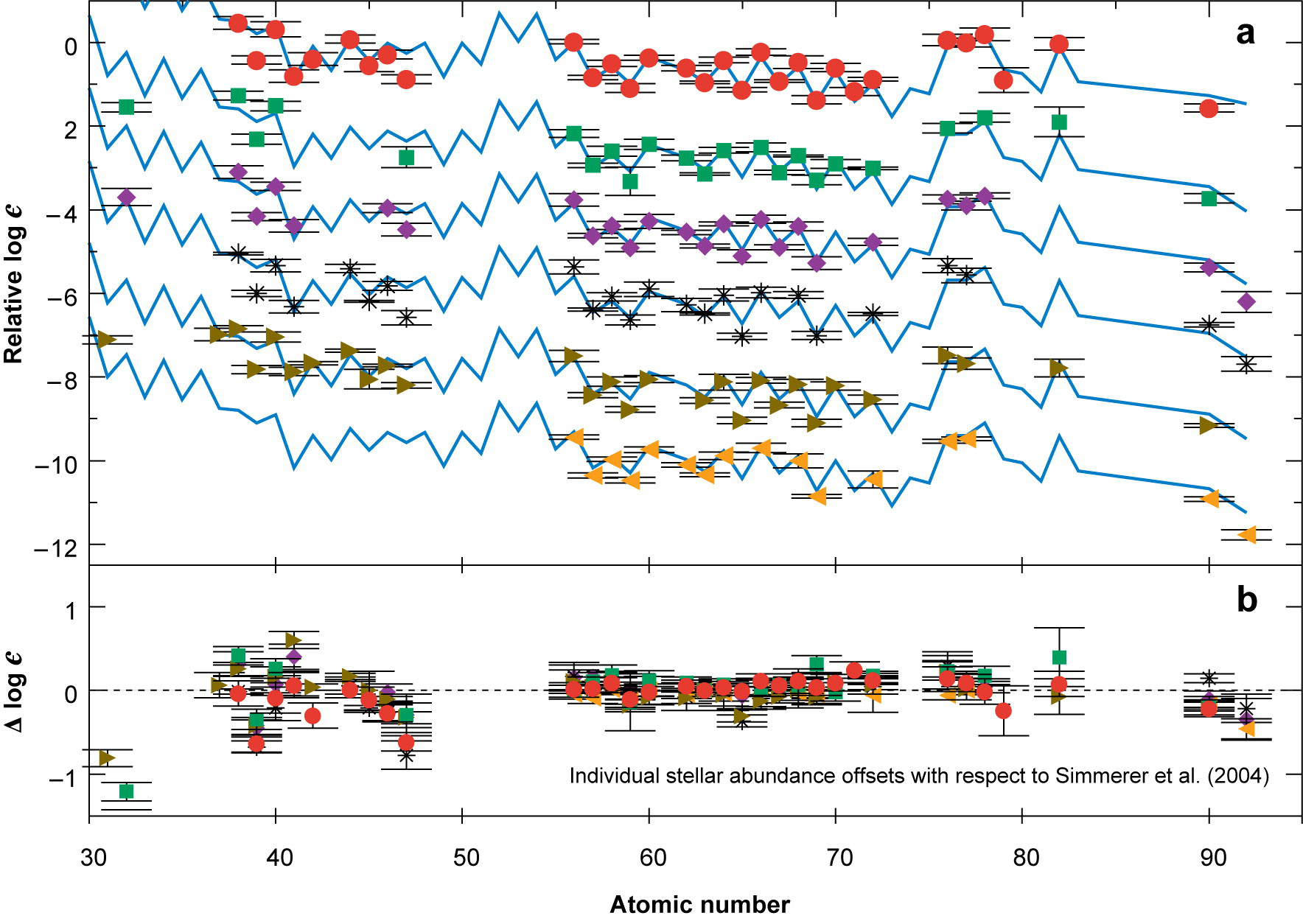20 β-delayed neutron emission probabilities across the Z=50 and N=82 shell closure: Implication on the formation of the second r-process peak
Vi Ho Phong
RIKEN Nishina Center
On Behalf of the BRIKEN collaboration
-
Outstanding problems on the formation of the second (A~130) r-process abundance peak: from astrophysical observations to nucleosynthesis models
-
β-delayed neutrons emission probabilities \(P_{n}\) as important inputs for r-process calculations.
-
New experimental \(P_{n}\) values their impacts on:
-
Benchmarking the theoretical \(\beta\)-decay models
-
Odd-even pattern of the second r-process peak
-

The second r-process peak: observational clues
Vi H. Phong | AwRI conference | June 15\(^{th}\) 2022
- Te and Sb discrepancy:
- The second peak is shifted to lower mass compared to solar abundance?
- Additional contributions to the robust "main" r-process?
- The second r-process peak is expected to be sensitive to the r-process conditions

robust pattern
star-to-star scatter
C. Sneeden et al. 2008

I. Roederer et al. 2022

Deficient: Te and Sb


- Down to which Z the "universality" hold?
Metal-poor stars observation: r-process "universality"
Nucleosynthesis relevant to the second r-process peak

S. Shibagaki el al. 2016, N. Nishimura et al. 2015
Magneto-hydrodynamic jet (MHDJ) model
S. Lemaître et al. 2020 and E. Eicher et al. 2015
Neutron star merger model
- In various scenarios, abundance pattern of the second r-process peak is effectively shaped by the \(\beta\)-decay path to stability during freezeout, which mostly determined by the \(\beta\)-delayed neutrons
\(\beta\)-delayed neutrons of r-process radioactive progenitors

$$P_{xn} = T_{1/2} \int^{Q_{\beta}}_{S_{xn}} S_{\beta}(E_{x}) f(Z,A,Q_{\beta}-E_{x})$$
$$T_{1/2} = \int^{Q_{\beta}}_{0} S_{\beta}(E_{x}) f(Z,A,Q_{\beta}-E_{x})$$
- Quantified by the β-delayed x neutron emission probability \(P_{xn} = N_{\beta xn} / N_{\beta}\) , \(P_{n} = P_{1n} + P_{2n}+ P_{3n}+...\)
- Alter the decay path to stability during freezout
- Additional source of neutrons for late neutron-capture


A. Arcones & G. Martinez-Pinedo 2011
Odd-even pattern
Final nucleous
Precursor
However...

A. Arcones & G. Martinez-Pinedo 2011
\(Q_{\beta 1n} \)
\(Q_{\beta 2n} \)
Emitter

K. Farouqi et. al. 2011
Large scale survey of \(P_{xn}\): the BRIKEN project
BRIKEN: \(\beta\)-delayed neutron emission probability measurements at RIKEN

RI seperation
RI identification
BRIKEN aims for:
- Most neutron-rich nuclei: RIBF SRC+ BigRIPS spectrometer
- Largest detection efficiency: \(^{3}\)He-based neutron detector array + highly segmented implantation detector array: AIDA / WAS3ABi.


\(P_{xn}\) measurements of neutron-rich nuclei across the Z=50 and N=82 shell closures

r-process path [S. Shibagaki el al. 2016]


Experimental results: feedback to theoretical \(\beta\) decay models


N=84
Z=49 \(\rightarrow\) 50
Crucial benchmarks for the theoretical models for predicting \(P_{xn}\)
- Statistical Hauser-Feshbach (HF) models of competition between neutron emission channels and \(\gamma\)
- Gamow-Teller \(\leftrightarrow\) First-Forbidden competition
- Large disagreement between the between still observed for \(^{136}In\)
P. Moller et. al. 2019
F. Minato et. al. 2021
I. Borzov et. al. 2020
With HF
Impact on the odd-even pattern of the second r-process peak
Skynet + Nucnet codes [J. Lippuner 2015, B. S. Mayer 2007]
Baseline simulation: Y\(_{e}\) = 0.06, S = 12 \(k_{b}\)/b and \(\tau\) = 66 ms

- Effect on shaping final odd-even pattern is prominent with and without beta delayed neutrons
- Removing up to 30 % uncertainties deriving from theoretical models
- Significant contribution of \(\beta\)1n and \(\beta\)2n flows defines the odd-even pattern in the right-wings of the second r-process peak

Freezout flows and final abundances:
\(^{135}\)In
\(^{134}\)Sn
\(^{136}\)Sn
\(^{131}\)Ag
Further investigation on the odd isotope fraction of Ba


Robust odd-even pattern for low Ye
Improvement of Ba isotopic abundances using the current experimental results.
\(f_{odd,Ba}\) = \((Y_{135Ba}+Y_{137Ba})/Y_{Ba}\)
Metal poor stars \(f_{odd,Ba}\)
C. Wenyuan et al. 2015
Summary
- New observations of the elements of the second r-process peak calls for new comparison between models and observation.
- Knowledge on the beta-delayed neutron emission probabilities \(P_{xn}\) is essential for modeling the formation of second r-process peak during freezeout
- \(P_{1n}\) and \(P_{2n}\) of 20 neutron-rich progenitors of the second r-process peaks have been measured within the BRIKEN project at RIKEN
- New experimental data provide benchmarks for development of theoretical \(\beta\)-decay models and direct impacts on the odd-even pattern of the second r-process
- In particular, improving the calculation of odd Ba fractions matching the metal-poor star observations.
Backup slices
Optimizing baseline trajectory

FRDM+QRPA+HF
Exp.
Data analysis

•Sorting the data produced from 3 independent DAQ
•Merging the data from 3 DAQs based on time-stamp
•Time and position correlation → β decay curves: Tβ − Timplant
\(\beta\)-implant
\(\beta\)1n-implant
\(\beta\)2n-implant
Impact of \(\beta\)-delayed neutrons in various scenarios

Neutron detection efficiency

